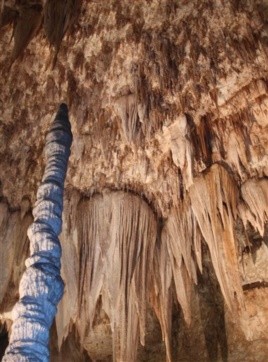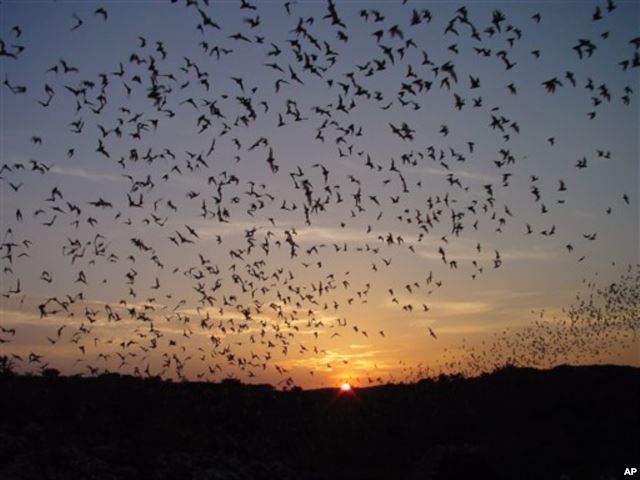VOA慢速英语:另一番景象:卡尔斯巴德洞窟国家公园
From VOA Learning English, welcome to This isAmerica. I’m Steve Ember.
This week on our program, we explore a UNESCOWorld Heritage Site in the American Southwest, nearthe city of Carlsbad, New Mexico.
Carlsbad Caverns National Park contains more than100 caves below the surface of the desert. Most areclosed to the public. But anyone can visit the mainattraction, one of the largest caves in the world.
Stalactites and stalagmites
Huge. Incredible. Inspiring. Words like these come tomind as visitors enter a world of silence, darkness andcold, almost 230 meters under the ground. Come along with us, as BobDoughty and Barbara Klein tell you about Carlsbad Caverns.
An elevator lowers you into the world of Carlsbad Cavern, the big cave atCarlsbad Caverns National Park. Silent, except for the voices of guides andvisitors. And not completely dark. The National Park Service has enoughlighting to see many of the beautiful formations all around. The temperature isabout 13 degrees Celsius.
 |
|
This Dec. 18, 2010 photo shows stalactites and a lone stalagmite in the Big Room at Carlsbad Caverns NationalPark near Carlsbad, N.M. More than 400,000 people visit Carlsbad Caverns each year to get a glimpse of themonumental stalagmites and stalactites |
A cavern is a large cave. But Carlsbad Cavern is really a long series ofchambers. One of these is called the Big Room. The Big Room is more thanthree hectares big. The ceiling is 77 meters high. The Big Room is the singlelargest underground chamber ever found in North America.
The Big Room and other parts of the cavern contain huge, sharp formations ofminerals. People are free to explore the lit formations in the Big Room. Butpark rangers must guide visitors to other areas of the cave.
hang from the ceiling. Stalagmites rise from the floor. Some even meet to create a column. Otherformations look like needles, popcorn, pearls andflowers.
A visitor still remembers the memory aid she learnedlong ago from her fifth-grade teacher. Stalactites haveto hang on "tight" to the ceiling or they might fall off. And be careful about stalagmites -- you "might" trip over oneon the floor.
One of the first questions that visitors have is how didCarlsbad Cavern form? Guides explain that it did notresult from the action of water and streams like otherlimestone caves. Instead, it was created by the actionof sulfuric acid.
The limestone developed about 250 million years ago.Then, within the last 20 million years, movements in theearth pushed the rock upward, forming the GuadalupeMountains. Today these mountains extend from westTexas into southeast New Mexico.
The action of oil and natural gas created hydrogen sulfide in the limestone. The hydrogen sulfide reacted with oxygen in rainwater moving through therock. Sulfuric acid developed. The acid created the caves by dissolving thelimestone in its path.
Later, the water and most of the acid left the caves as the GuadalupeMountains continued to rise. This permitted freshwater to move through. Thefreshwater left behind minerals. These minerals became the formations andshapes on the ceilings, walls and floors of the caves.
Summer home to thousands of Mexican bats
People are not the only ones who visit Carlsbad Caverns National Park. About400,000 Mexican free-tailed bats come to the big cave from Mexico eachsummer to give birth.
Every evening, as the sun goes down, thousands of adult bats fly out of thenatural entrance of the cave. It can take from twenty minutes to more than twohours for them all to leave. The bats fly to nearby river valleys to feed on night-flying insects. Then, toward morning, they return to the bat cave withinCarlsbad Cavern.
Park Service rangers explain that mother bats find their babies byremembering their location, their smell and the sound of their cry. Mothers andpups hang in groups on the ceiling. They spend the day resting and feeding.
 |
|
This 2005 photo supplied by the National Park Service shows the nightly exodus of bats from Carlsbad CavernsNational Park in New Mexico. |
While the adults go out at night for food, the young bats hang out in the cavefor four or five weeks. Then, in July or August, they join their mothers on thesenightly flights.
Finally, in late October or early November, the bats all leave and return toMexico. But they always return the next year.
It is easy to imagine that it was the bats that led ancient people to discover thecave. Archeologists and others have found evidence of Ice Age hunters nearthe cave entrance. They have also found pieces of spear points left about10,000 years ago.
More recently, Apache Indians painted pictures at the entrance. And evidenceof one of their cooking areas was found beside a nearby path.
Curious teen found the cavern around 1900
Around 1900, a teenage cowboy named James Larkin White began to explorethe cave.
Jim White told his story in the 1932 book "The Discovery and History ofCarlsbad Caverns." Here is a reading of his description of his first sight of thebats and the big cave:
"I thought it was a volcano, but then, I’d never seen a volcano -- nor neverbefore had I seen bats swarm, for that matter. During my life on the range I’dseen plenty of prairie whirlwinds -- but this thing didn’t move; it remained inone spot, spinning its way upward. I watched it for perhaps a half-hour -- untilmy curiosity got the better of me. Then I began investigating …
"I worked my way through the rocks and brush until I found myself gazing intothe biggest and blackest hole I had ever seen, out of which the bats seemedliterally to boil …
"The more I thought of it, the more I realized that any hole in the ground thatcould house such a gigantic army of bats must be a whale of a big cave … Icrept between cactus until I lay on the brink of the chasm, and looked down.During all the years I'd known of the place, I'd never taken the trouble to dothis. There was no bottom in sight! I shall never forget the feeling of awenessit gave me."
Jim White told how he built a ladder from rope, wire and sticks and returned to the entrance of the cave a few days later.
"I found myself climbing down, down, deeper and deeper into the blackness ... At last my feet touched something solid. I lighted my lantern, and found that I was perched on a narrow ledge, almost at the end of my rope -- literally andfiguratively.
"By now I could see into the tunnel -- it wasn’t much farther down to the floorof it, and that floor looked smooth and level. I decided that with a little exhibitionof human-fly stuff, I could hold onto the rough wall and go down another twentyfeet to level territory.
"Standing at the entrance of the tunnel I could see ahead of me a darkness soabsolutely black it seemed a solid. The light of my lantern was but a sicklyglow. Nevertheless, I forged ahead, and with each step the tunnel grew larger, and I felt as though I was wandering into the very core of the GuadalupeMountains."
A few years later, a settler named Abijah Long also found the entrance andwent into the cavern. He found huge amounts of bat droppings.
Abijah Long hired local workers to mine the guano which he sold to farmers asfertilizer. At the same time, he explored much of the caves. Some peoplemight even say Abijah Long was the first real explorer of Carlsbad Cavern.
But Jim White made it his life’s work to make sure the public would see andenjoy the cavern. He worked on Abijah Long’s mining operation for 20 years.
The authors of the book "Carlsbad Cavern: The Early Years" say Jim Whitetook the job for the chance to keep exploring the cave. And after the miningoperation closed, he started building paths in the cavern. Yet once he hadenough paths built to welcome visitors, no one seemed interested in his "batcave."
Then, in 1918, Jim White took a professional photographer into the cave. RayDavis' pictures of the Big Room appeared in the New York Times. Nationalinterest began to grow.
In 1923, scientists from the National Geographic Society explored the caves. The following year, President Calvin Coolidge named Carlsbad a nationalmonument. Presidents can declare national monuments, but Congress mustact to establish a national park. And that is what Congress did in 1930.
Since then, parts of Carlsbad Caverns have been used for movie sets,weddings, even meetings of the Carlsbad City Council.
Most visitors go to the main cavern. But some experienced cavers arepermitted to explore five "wild" caves in the park. And in another one,scientists are studying microbes in search of a cure for cancer.
As for Jim White, he became chief ranger of Carlsbad Caverns. In his story in the book "The Discovery and History of Carlsbad Caverns," he talks about allthe work that was done.
"I doubt if you can understand how happy this modernizing has made me. It'slike the pleasant end to a dream."
Our program was written by Nancy Steinbach and produced by DanaDemange. I’m Bob Doughty.
And I’m Barbara Klein. Doug Johnson was our reader.
This is America is a production of VOA Learning English. I’m Steve Emberinviting you to join us again next week.
- 频道推荐
- |
- 全站推荐
- 推荐下载
- 网站推荐




















